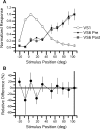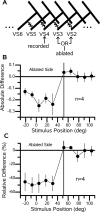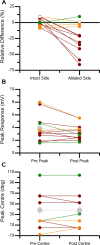Sharing receptive fields with your neighbors: tuning the vertical system cells to wide field motion
- PMID: 15829650
- PMCID: PMC6724919
- DOI: 10.1523/JNEUROSCI.0168-05.2005
Sharing receptive fields with your neighbors: tuning the vertical system cells to wide field motion
Abstract
In the blowfly, the direction-selective response of the 60 lobula-plate tangential cells has been ascribed to the integration of local motion information across their extensive dendritic trees. Because the lobula plate is organized retinotopically, the receptive fields of the tangential cells ought to be determined by their dendritic architecture. However, this appears not always to be the case. One compelling example is the exceptionally wide receptive fields of the vertical system (VS) tangential cells. Using dual-intracellular recordings, Haag and Borst (2004) found VS cells to be mutually coupled in such a way that each VS cell is connected exclusively to its immediate neighbors. This coupling may form the basis of the broad receptive fields of VS cells. Here, we tested this hypothesis directly by photoablating individual VS cells. The receptive field width of VS cells indeed narrowed after the ablation of single VS cells, specifically depending on whether the receptive field of the ablated cell was more frontal or more posterior to the recorded cell. In particular, the responses changed as if the neuron lost access to visual information from the ablated neuron and those VS cells more distal than it from the recorded neuron. These experiments provide strong evidence that the lateral connections among VS cells are a crucial component in the mechanism underlying their complex receptive fields, augmenting the direct columnar input to their dendrites.
Figures







Similar articles
-
Neural action fields for optic flow based navigation: a simulation study of the fly lobula plate network.PLoS One. 2011 Jan 31;6(1):e16303. doi: 10.1371/journal.pone.0016303. PLoS One. 2011. PMID: 21305019 Free PMC article.
-
Neural mechanism underlying complex receptive field properties of motion-sensitive interneurons.Nat Neurosci. 2004 Jun;7(6):628-34. doi: 10.1038/nn1245. Epub 2004 May 9. Nat Neurosci. 2004. PMID: 15133514
-
Neurophysiological and simulation studies of striate cortex receptive field maps: the role of intracortical interneuronal interactions.Neurosci Behav Physiol. 2007 Jul;37(6):613-21. doi: 10.1007/s11055-007-0060-1. Neurosci Behav Physiol. 2007. PMID: 17657433
-
The contribution of vertical and horizontal connections to the receptive field center and surround in V1.Neural Netw. 2004 Jun-Jul;17(5-6):681-93. doi: 10.1016/j.neunet.2004.05.002. Neural Netw. 2004. PMID: 15288892 Review.
-
Gain modulation in the central nervous system: where behavior, neurophysiology, and computation meet.Neuroscientist. 2001 Oct;7(5):430-40. doi: 10.1177/107385840100700512. Neuroscientist. 2001. PMID: 11597102 Free PMC article. Review.
Cited by
-
Integration of lobula plate output signals by DNOVS1, an identified premotor descending neuron.J Neurosci. 2007 Feb 21;27(8):1992-2000. doi: 10.1523/JNEUROSCI.4393-06.2007. J Neurosci. 2007. PMID: 17314295 Free PMC article.
-
Robust coding of ego-motion in descending neurons of the fly.J Neurosci. 2009 Nov 25;29(47):14993-5000. doi: 10.1523/JNEUROSCI.3786-09.2009. J Neurosci. 2009. PMID: 19940195 Free PMC article.
-
Full reconstruction of large lobula plate tangential cells in Drosophila from a 3D EM dataset.PLoS One. 2018 Nov 28;13(11):e0207828. doi: 10.1371/journal.pone.0207828. eCollection 2018. PLoS One. 2018. PMID: 30485333 Free PMC article.
-
Neural action fields for optic flow based navigation: a simulation study of the fly lobula plate network.PLoS One. 2011 Jan 31;6(1):e16303. doi: 10.1371/journal.pone.0016303. PLoS One. 2011. PMID: 21305019 Free PMC article.
-
Different receptive fields in axons and dendrites underlie robust coding in motion-sensitive neurons.Nat Neurosci. 2009 Mar;12(3):327-32. doi: 10.1038/nn.2269. Epub 2009 Feb 8. Nat Neurosci. 2009. PMID: 19198603
References
-
- Bloomfield S, Völgyi B (2004) Function and plasticity of homologous coupling between AII amacrine cells. Vision Res 44: 3297-3306. - PubMed
-
- Borst A (2003) Noise, not stimulus entropy, determines neural information rate. J Comput Neurosci 14: 23-31. - PubMed
-
- Borst A, Haag J (2001) Effects of mean firing on neural information rate. J Comput Neurosci 10: 213-221. - PubMed
-
- de Ruyter van Steveninck R, Bialek W (1995) Reliability and statistical efficiency of a blowfly movement-sensitive neuron. Philos Trans R Soc Lond B Biol Sci 348: 321-340.
Publication types
MeSH terms
LinkOut - more resources
Full Text Sources
